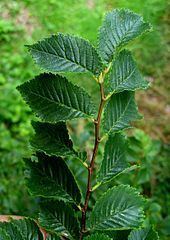Cultivar 'Stricta' Rank Subspecies | ||
 | ||
Similar Ulmus minor 'Goodyeri', Ulmus minor 'Purpurascens', Ulmus minor 'Propendens', Ulmus minor 'Schuurhoek', Ulmus laciniata var nikko | ||
The Field Elm cultivar Ulmus minor 'Stricta' known as the Cornish Elm, was commonly found in South West England, Southern Ireland and Brittany until the arrival of Dutch elm disease in the late 1960s. Dr Max Coleman of Royal Botanic Garden Edinburgh, arguing in his 2002 paper on British elms that there was no clear distinction between species and subspecies, suggested that known or suspected clones of Ulmus minor, once cultivated and named, should be treated as cultivars, preferred the designation U. minor 'Stricta'. The DNA of 'Stricta' has been investigated and the cultivar is now known to be a clone.
Contents
- Description
- Pests and diseases
- Cultivation and uses
- Stricta like elms
- Notable trees
- Varieties
- Hybrids
- Accessions
- Nurseries
- The Cornish Elm in art
- References
Mature trees are now largely restricted to Australia, whither it was introduced in the 19th century.
Description
Growing to a height of up to 27 metres (89 ft), the Cornish Elm is a slender, slow-growing deciduous tree, distinguished by its long, straight trunk, which culminates in a narrow fan-shaped crown comprising short, straight, ascending branches. The leaves are small, obovate to oval, typically acuminate at the apex, 6 cm long by 3.5 cm broad, with a dark-green upper surface, glossy and smooth. The perfect apetalous wind-pollinated flowers occur in clusters of 15–20 on very short pedicels. The samarae rarely ripened in England, but when mature were very similar to those of others in the Field Elm group, being mostly obovate, 16 mm long by 10 mm broad.
Dr Oliver Rackham (1986) noted that Cornish Elms with "more spreading" crowns grow around Truro and on the Lizard Peninsula, illustrating the variety, which he called 'Lizard Elm', with a 1980 photograph.
Pests and diseases
Cornish Elm is very susceptible to Dutch elm disease, but suckers remain a common component of hedgerows in parts of Cornwall, and thus the genetic resources of this cultivar are not considered endangered. Like other Field Elms, propagation is almost entirely by suckers, which the tree produces copiously.
Cultivation and uses
The origin of the Cornish Elm in England remains a matter of contention; commonly assumed to have been introduced from Brittany by Man, it is also considered possible that the species may have survived the Ice Ages on lands to the south of Cornwall long since lost to the sea. Without doubt, its current distribution owes much to man's activities, as it is the tree traditionally considered the best choice for providing shelter along the Cornish coast. Moreover, its timber was much prized for its strength, and commonly used in wheel and wagon construction. Working Cornish pilot gigs were traditionally built from Cornish Elm, and until recently the Rules of the Cornish Pilot Gig Association specified that to take part in gig races the boat should be made from "Cornish narrow-leaved elm".
Few mature specimens are known to survive in the wild in England. As of 2009, two are reputed to survive in East Sussex at Selmeston, near the footpath across the grounds of Sherrington Manor.
'Stricta' is not known to remain in commerce beyond Australia.
Stricta-like elms
An U. campestris cornubiensis was distributed by the Späth nursery, Berlin, in the early 20th century. Henry stated that the "beautiful narrow pyramidal tree" he had seen by that name in Späth's nursery differed from true Cornish Elm, bearing instead "leaves similar in size and appearance to a common form of U. nitens" [:U. minor]. Three specimens of Späth's U. campestris cornubiensis were supplied to the Royal Botanic Garden Edinburgh in 1902, one being planted in the Garden proper and cultivated as U. stricta, the other two being planted in the city. In 1958 Melville likewise queried Späth's Cornish Elm (see External links below, herbarium specimen E00824799); Edward Kemp, however, RBGE curator (1950-71), accepted it. A specimen of what appears from herbarium specimens to be the same clone survives (2016) in Edinburgh (height about 25 m, girth about 2 m), in Douglas Crescent Gardens. The latter also matches an 1825 herbarium specimen labelled "U. suberosa var., Hort. Millburn".
Notable trees
The Great Elm of Rosuic, an ancient pollard elm which attained a d.b.h. of over 2.5 metres (8.2 ft) before succumbing to disease, continues to produce suckers.
As of 2011, the Woodland Trust lists only one verified mature Cornish Elm surviving in Cornwall, a specimen 1.89 metres (6.2 ft) in girth at Tregoose near Helston. A small number of mature trees, with an average d.b.h. of 143 cm, survive at Castletownbere Cemetery in County Cork, Ireland. Another specimen, believed to be over a century old, exists in Shoreham, Victoria in Australia.
Varieties
The noted botanist Ronald Melville considered Goodyer's Elm a variety of the Cornish Elm.
Hybrids
It has been suggested that the cultivar 'Daveyi' is a natural hybrid of Wych elm and Cornish elm; likewise 'Exoniensis'. The botanist F. J. Fontaine conjectured that the cultivar Ulmus 'Purpurea' is related to the Cornish Elm.
Accessions
Nurseries
The Cornish Elm in art
Landscape-paintings depicting Cornish Elm include Holman Hunt's watercolour Helston, Cornwall (1860), showing hedgerow elms, and the watercolour Egloshayle, Cornwall by Thomas Campbell-Bennett (1858-1948), showing Cornish Elms beside the River Camel, opposite the church of St Mary, Egloshayle. The latter illustrates Gerald Wilkinson's observation that "In its normal habitat the Cornish Elm often has a flat, wind-cut top".
